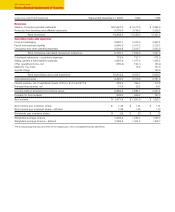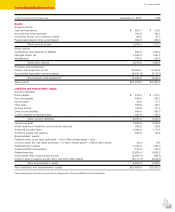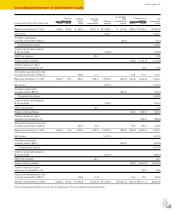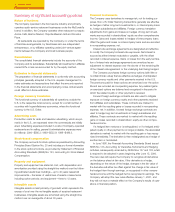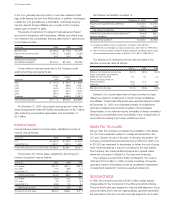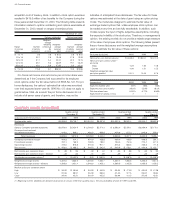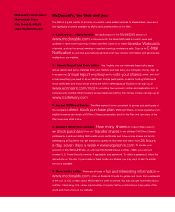McDonalds 2000 Annual Report Download - page 45
Download and view the complete annual report
Please find page 45 of the 2000 McDonalds annual report below. You can navigate through the pages in the report by either clicking on the pages listed below, or by using the keyword search tool below to find specific information within the annual report.
the Company reduced home office staffing by approximately
500 positions, consolidated certain home office facilities and reduced
other expenditures in a variety of areas. The special charge was
composed of $85.8 million of employee severance and outplacement
costs, $40.8 million of lease cancellation and other facilities-related
costs, $18.3 million of costs for the write-off of technology invest-
ments made obsolete as a result of the productivity initiative and
$15.1 million of other cash payments made in 1998. The initiatives
identified in the home office productivity plan were completed as of
December 31, 1999, and no significant adjustments were made to
the original plan.
Debt financing
Line of credit agreements
At December 31, 2000, the Company had several line of credit
agreements with various banks totaling $1.9 billion, all of which
remained unused at year-end 2000. Subsequent to year end, the
Company reduced these line of credit agreements to $1.5 billion,
consisting of the following: a $750.0 million line with a renewable
term of 364 days and fees of .04% per annum on the total commit-
ment, with a feature that allows the Company to convert the
borrowings to a one-year term loan at any time prior to expiration;
a $500.0 million line expiring in February 2006 with fees of .06%
per annum on the total commitment; $250.0 million in lines expiring
during 2001 and fees of .04% per annum on the total commitment;
and a $25.0 million line with a renewable term of 364 days and fees
of .07% per annum on the total commitment. Borrowings under the
agreements bear interest at one of several specified floating rates
selected by the Company at the time of borrowing. In addition, cer-
tain subsidiaries outside the U.S. had unused lines of credit totaling
$751.4 million at December 31, 2000; these were principally short
term and denominated in various currencies at local market rates of
interest. The weighted-average interest rate of short-term borrowings,
composed of U.S. Dollar and Euro commercial paper and foreign
currency bank-line borrowings, was 6.9% at December 31, 2000
and 6.1% at December 31, 1999.
Exchange agreements
The Company has entered into agreements for the exchange of
various currencies, certain of which also provide for the periodic
exchange of interest payments. These agreements expire through
2005 and relate primarily to the exchange of Euro. The notional
principal is equal to the amount of foreign currency or U.S. Dollar
principal exchanged at maturity and is used to calculate interest
payments that are exchanged over the life of the agreement. The
Company has also entered into interest-rate exchange agreements
that expire through 2012 and relate primarily to Euro, U.S. Dollars
and Japanese Yen. The net value of each exchange agreement
based on its current spot rate was classified as an asset or liability.
Net interest is accrued as either interest receivable or payable, with
the offset recorded in interest expense.
The counterparties to these agreements consist of a diverse
group of financial institutions. The Company continually monitors its
positions and the credit ratings of its counterparties, and adjusts
positions as appropriate. The Company does not have significant
exposure to any individual counterparty and has entered into master
agreements that contain netting arrangements. The Company’s
policy regarding agreements with certain counterparties is to require
collateral in the event credit ratings fall below A- or in the event that
aggregate exposures exceed certain limits as defined by contract. At
December 31, 2000, no collateral was required of counterparties and
the Company was not required to collateralize any of its obligations.
At December 31, 2000, the Company had purchased foreign
currency options outstanding (primarily Euro, Japanese Yen and
British Pounds Sterling) with a notional amount equivalent to
$453.0 million. The unamortized premium related to these foreign
currency options was $10.6 million, and there were no related
deferred gains recorded as of year end. Forward foreign exchange
contracts outstanding at December 31, 2000 (primarily British
Pounds Sterling, Hong Kong Dollars and Euro) had a U.S. Dollar
equivalent of $781.8 million.
Fair values
December 31, 2000
IN MILLIONS Carrying amount Fair value
Liabilities
Debt $8,154.7 $8,344.0
Notes payable 275.5 275.5
Foreign currency exchange agreements (1) 43.7 45.6
Total liabilities 8,473.9 8,665.1
Assets
Foreign currency exchange agreements (1) 39.6 39.2
Interest-rate exchange agreements (2) 16.3
Net debt $8,434.3 $8,609.6
Purchased foreign currency options $ 10.6 $ 16.9
(1) Gross notional amount equivalent to $462.6 million.
(2) Notional amount equivalent to $2.9 billion.
The carrying amounts for cash and equivalents, notes receivable
and forward foreign exchange contracts approximated fair value.
No fair value was provided for noninterest-bearing security deposits
by franchisees as these deposits are an integral part of the overall
franchise arrangements.
The fair values of debt, notes payable obligations, foreign currency
and interest-rate exchange agreements and foreign currency options
were estimated using various pricing models or discounted cash
flow analyses that incorporated quoted market prices. The Company
has no current plans to retire a significant amount of its debt prior to
maturity. Given the market value of its common stock and its signifi-
cant real estate holdings, the Company believes that the fair value of
its total assets was substantially higher than the carrying value at
December 31, 2000.
Financial review 43





